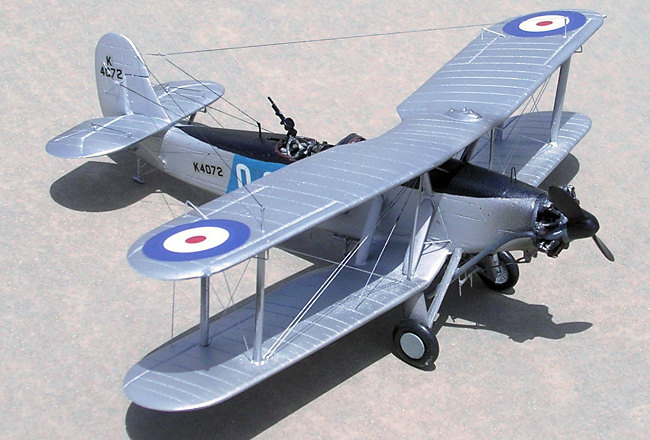
Contrail 1/72 Blackburn Baffin/Ripon
| KIT #: | ? |
| PRICE: | £9.50 |
| DECALS: | Three options |
| REVIEWER: | Carmel J. Attard |
| NOTES: | Vacuform with injected parts. |

| HISTORY |
As aircraft gained in power, the carriage of a torpedo became
more feasible and both British and German sea planes carried out a few
successful torpedo attacks against ships. In those early days the Sopwith
Cuckoo, a single engined torpedo bomber was to be the instrument and No 185 Sq
at East Fortune in Scotland was working up for such an operation. The torpedo
bomber became part of the fleet armoury and continued to be developed. The
Cuckoo was followed by the Blackburn Dart that flew from HMS Argus, Hermes and
Eagle as well as conducted torpedo dropping trials from land bases like Hal Far
in Malta. Specification was then issued to aircraft manufacturers on 16th
June 1924 for a two seat torpedo carrying ship-plane for the Fleet Air Arm. The
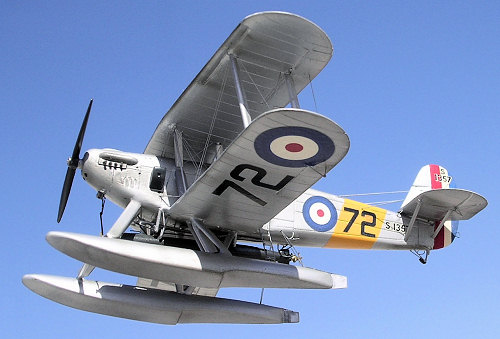 additional seat would provide self defence if intercepted by single-seat carrier
fighters. The requirement for this specification was that the aircraft had to be
able to operate from a carrier deck, should have good controllability at low
speeds, be able to fly steadily for torpedo dropping and precision bombing and
have a view for the pilot, and would be manoeuvrable and capable for self
defence.
additional seat would provide self defence if intercepted by single-seat carrier
fighters. The requirement for this specification was that the aircraft had to be
able to operate from a carrier deck, should have good controllability at low
speeds, be able to fly steadily for torpedo dropping and precision bombing and
have a view for the pilot, and would be manoeuvrable and capable for self
defence.
The specification also contained other technical data requirements: powered by a 470hp Napier Lion II, fuel tanks self sealing type, having a cooling radiator, engine silencer, having one fixed 0.303ins machine gun and one 0.303 inch Lewis machine gun on a No2 Scarf mounting, one 18 torpedo and able to carry 12 bombs, two pyrene fire extinguishers, electrical fitment requirement etc etc. There were three contenders at the time and the Blackburn Ripon entrant was one which also won the contract.
The Ripon used the basic Blackburn Velos structure but with
a cleaner design and in production aircraft the nose assumed its final
streamlined shape. Preliminary carrier trials were carried out by the Ripon in
May 1926 and after catapult trials at Gosport, the prototype returned to Bough.
After more trials at MA&AEE at Felixstowe the Ripon went to sea plane trials as
interchangeable wheels and floats were required for all carrier types. The
Blackburn Company used a number of radial engines fitted to their Ripons. One
had a 650hp Armstrong Siddeley Tiger I engine while another received a 545hp
Bristol Pegasus engine. The designation T5J Ripon MkV was applied with both
machines which were otherwise known as B-4 and B-5 respectively. Following
competitive trials, the latter version was selected as a new first-line warplane
powered by a Pegasus I M3 engine. Earlier Ripon MkII was converted to the new
standard giving the name Baffin. Structurally the Baffin was similar to the
Ripon IIC apart from the engine mounting. Conversion from Ripons was
comparatively easy and covered 68 aircraft. Replacement of the Pegasus IM3 with
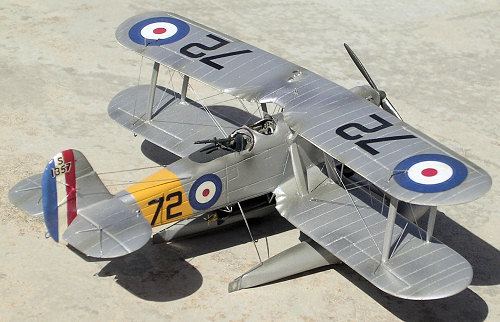 a 580hp Pegasus IIM3 was covered by Spec 17/34. This carrier and land based
torpedo bomber had a maximum speed of 136mph at 6,500 and a climb rate of 480ft
per minute, a service ceiling of 15,000ft and a range of 450 miles. It had a
wing span of 4561/2, a length of 38 31/4 and a height of 1210. Armament
consisted of one 0.303 Vickers fixed forward firing machine gun in forward
fuselage and one 0.303in Louis trainable rearward firing machine gun in rear
cockpit plus one torpedo or up to 2,00lb bombs carried externally. More than 60 Ripons were re-engined to Baffin standard. The improved performance proved
little better than that of the predecessor and the Baffin had a short front-line
life.
a 580hp Pegasus IIM3 was covered by Spec 17/34. This carrier and land based
torpedo bomber had a maximum speed of 136mph at 6,500 and a climb rate of 480ft
per minute, a service ceiling of 15,000ft and a range of 450 miles. It had a
wing span of 4561/2, a length of 38 31/4 and a height of 1210. Armament
consisted of one 0.303 Vickers fixed forward firing machine gun in forward
fuselage and one 0.303in Louis trainable rearward firing machine gun in rear
cockpit plus one torpedo or up to 2,00lb bombs carried externally. More than 60 Ripons were re-engined to Baffin standard. The improved performance proved
little better than that of the predecessor and the Baffin had a short front-line
life.
Ripons and Baffins were only used in small numbers on
board carriers. This was for two reasons: first due to economic situation at the
time which restricted the operations in peace time and the other was the
limitations of the actual carriers themselves. The three sister ships of the
Courageous class were all converted to carriers, Furious, initially
being an experiment with the original super structure in place and two flying
decks, one fore and one aft. The aft deck was added when landing on foredeck
proved highly dangerous. Unfortunately turbulence from the bridge and from
funnels made it difficult to land and it was decided to rebuild Furious as a
flush deck carrier. In this form it joined the fleet in September 1925. In
February 1928 Courageous was commissioned and Glorious in January 1930. Each
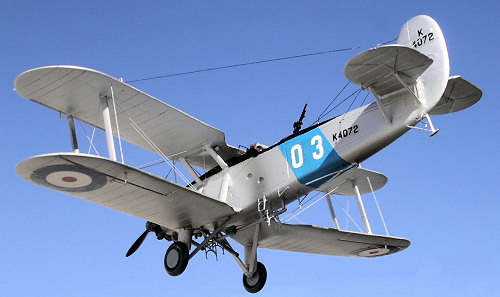 had a single hangar which had
opening doors at each end. The bow doors could be opened to allow aircraft to
run-up in the hangar, with acute discomfort to anyone in the vicinity, and then
be flown off over the bow. Employed mainly for Flycatchers, this allowed the
flight deck to be used by heavier aircraft as the Ripon. The after doors allowed
seaplanes to be swung out from quarterdeck on a pair of fitted seaplanes cranes.
The normal complement was only 36 aircraft, half that of the contemporary US
Navy carriers although this later went up to 48. The US Navy carriers had been
built on the hulls of cancelled 43,000 ton battle cruisers and were much larger.
The British Treasury would not look further than cash savings cancellations
would make after the end of the war and the Washington treaty restricted the
number of capital ships but permitted the construction of aircraft carriers. At
22,000 tons each for the three British carriers against 37,000tons each for the
two US carriers (The treaty was 33,000 Tons) the flight deck lengths were 520 ft
and 850 ft respectively with corresponding hangar space.
had a single hangar which had
opening doors at each end. The bow doors could be opened to allow aircraft to
run-up in the hangar, with acute discomfort to anyone in the vicinity, and then
be flown off over the bow. Employed mainly for Flycatchers, this allowed the
flight deck to be used by heavier aircraft as the Ripon. The after doors allowed
seaplanes to be swung out from quarterdeck on a pair of fitted seaplanes cranes.
The normal complement was only 36 aircraft, half that of the contemporary US
Navy carriers although this later went up to 48. The US Navy carriers had been
built on the hulls of cancelled 43,000 ton battle cruisers and were much larger.
The British Treasury would not look further than cash savings cancellations
would make after the end of the war and the Washington treaty restricted the
number of capital ships but permitted the construction of aircraft carriers. At
22,000 tons each for the three British carriers against 37,000tons each for the
two US carriers (The treaty was 33,000 Tons) the flight deck lengths were 520 ft
and 850 ft respectively with corresponding hangar space.
A typical shore base frequented by both the Ripon and the
Baffin was that of Hal Far in Malta. This airfield has a long history being the
first permanent airfield to be built on the island. It was initially attached to
the Malta Naval Stations at Kalafrana. The airfield was
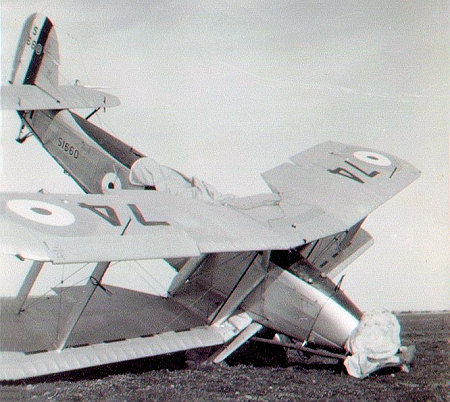 officially opened on
16.1.23 by his Excellency Field Marshal Lord Plumer, who was the Governor&
Commander in Chief, accompanied by the Premier of Malta, Ministers and senior
Naval and Army officers. The Naval aircraft that used the airfield in those
early days were Flycatchers, Bisons, Darts, Fairey IIIDs, Nimrods, Seals, Harts
and the list goes on and on. The first Baffins came into Hal Far when in April
1934 these flew from HMS Glorious. Later these spent some time on other carriers
before 810 Sq returning to Hal Far on 22nd March 1935. Then HMS
Courageous flew in Baffins of 811Sq and in June 1935 flying Baffins from HMS
Furious. 812 Sq from HMS Glorious flew in Baffins many times from April 1933.
officially opened on
16.1.23 by his Excellency Field Marshal Lord Plumer, who was the Governor&
Commander in Chief, accompanied by the Premier of Malta, Ministers and senior
Naval and Army officers. The Naval aircraft that used the airfield in those
early days were Flycatchers, Bisons, Darts, Fairey IIIDs, Nimrods, Seals, Harts
and the list goes on and on. The first Baffins came into Hal Far when in April
1934 these flew from HMS Glorious. Later these spent some time on other carriers
before 810 Sq returning to Hal Far on 22nd March 1935. Then HMS
Courageous flew in Baffins of 811Sq and in June 1935 flying Baffins from HMS
Furious. 812 Sq from HMS Glorious flew in Baffins many times from April 1933.
A tornado which struck Malta on 24th of November
1936 demolished three hangars at Hal Far damaging all the aircraft of 802 Sq and
812 Sq which were in a period of temporary disembarkation. Seven of 812 Squadron
Baffins were badly damaged that they had to be struck off charge. The Government
and AOC visited the site but all they could do was to issue instructions for
rebuilding to begin. The aircraft which has flown in for a few days before from
carrier Eagle and Glorious and seven among them that were scrapped completely
were Baffins with registrations: K2884, K2885, K3559, K3590, S1558, S1559,
K4776, K4778, S1468, S1569, S1574, S1652, and S1666. Other Baffins shipped to
Malta to operate from Hal Far were: K3546, K3547, K3548, K3549, K3550, K3551,
K3552, K353, K3554, K3555, K3556, K3557, and K3558. The Ripon and Baffin
experience in Malta did not go as smooth as one would have desired. Ripon II
S1265 ditched off Malta on 25.4.32 and was salvaged; S1360/60 of 461 Flight HMS
Glorious crashed in December 1930 in St Pauls Bay. Another Ripon II S1362
crashed in sea off Valletta Point on
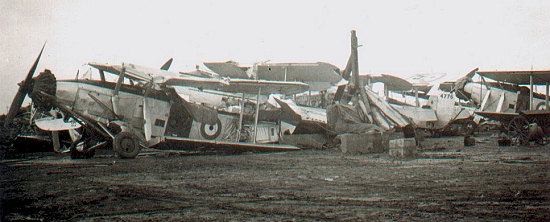 10.10.31; S1429 force landed in the sea and
sank while flying from HMS Glorious en route Malta to Naples 11.3.32; S1465
crashed in sea off Hal Far on 14.11.32, S1469 crashed into stone wall at Hal Far
in June 1931; S1660 crashed in small ploughed field hitting wall in grounds of
monastery 18.9.36.
10.10.31; S1429 force landed in the sea and
sank while flying from HMS Glorious en route Malta to Naples 11.3.32; S1465
crashed in sea off Hal Far on 14.11.32, S1469 crashed into stone wall at Hal Far
in June 1931; S1660 crashed in small ploughed field hitting wall in grounds of
monastery 18.9.36.
The last FAA Baffin aircraft finally being declared obsolete in1937. This was not the end of the type because New Zealand bought 12 Baffins at the rock bottom price of £200 each to equip Territorial Squadrons at Wellington formed July 1937and a further 17 followed becoming the only examples of the type to serve in WWII. Most of them had been withdrawn by 1941. The Baffin was a handsome Blackburn design and although replaced by the Blackburn Shark the type remains as one of the early two seat carrier borne and land based aircraft that continued to pave the way to later types as the Swordfish which remained among the famous aircraft in WWII history.
| THE KIT |
The kit comes packed in a sizeable card
board box with side views drawing of the Baffin and Ripon depicted over a light
blue background. Enclosed was a polytene bag containing basically two white
plastic sheets with all the major model pieces as the fuselage, wings, a torpedo
and a pair of floats, there are injection moulded items in black pl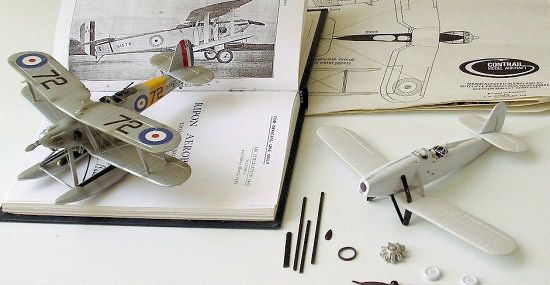 astic
for parts as the radial engine, two different propellers, wheels, exhaust pipes
and struts. These provide sufficient parts to make two complete kits out of a
selection of three.
astic
for parts as the radial engine, two different propellers, wheels, exhaust pipes
and struts. These provide sufficient parts to make two complete kits out of a
selection of three.
A good decal sheet is also provided and has sufficient items on it to make any two from the following selection of three options:
a) Ripon S1427 (60) on wheels which is finished in shades of aluminium and dark grey upper fuselage decking. This contained a blue band across fuselage and a three colour rudder.
b) Ripon II on floats S1357 (72) which is aluminium overall having a yellow fuselage band and a three colour rudder.
c) Baffin K4072(03) which is aluminium overall with black decking.
All three can carry a torpedo under the fuselage.
| CONSTRUCTION |
The instructions given are easy to follow with sketches for jigs to assist one to obtain the correct stagger between the upper and lower wings. In short this is a good basic kit but definitely yearns for the refining detail that goes inside the open cockpits as well as on the outside of the aircraft. The instructions also suggest the basic equipment considered necessary to vac-form modellers particularly to those who are building vac form kits for the first time.
As a standard procedure all the parts are
first marked with a soft pencil on the outside of each vac form item and are
then separated from the backing sheet by sharply scoring a line close to moulded
edge to allow surplus material to be cracked off. The edges are then removed
using a file and wet and dry sanding along the cut lines of each cut part. This
is done until all mating surfaces are smooth and true. Over sanding is to be
avoided and constant checking of the parts mated together is a necessity.
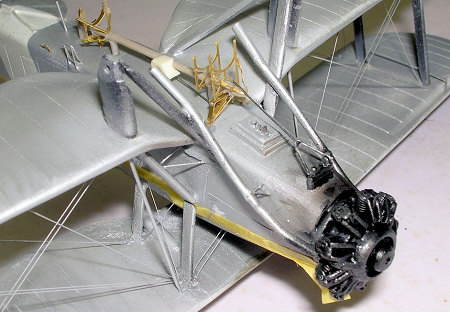 This
requires reference to the scale plans to ensure that the correct amount of
sanding is done. The vac form pieces containing the fin and rudder and tail
planes and elevators needed extra sanding towards the trailing edge. I also
found that these required sanding even on the outside surfaces to rid off the
blistered effect in the moulding which was very apparent.
This
requires reference to the scale plans to ensure that the correct amount of
sanding is done. The vac form pieces containing the fin and rudder and tail
planes and elevators needed extra sanding towards the trailing edge. I also
found that these required sanding even on the outside surfaces to rid off the
blistered effect in the moulding which was very apparent.
The injection moulded struts which came in black plastic strips are first identified with the scale plans and are separated from sprue using a sharp exacto knife. Surplus flash removed and edges rounded off a little. As mentioned earlier, detailing the pilot and gunner office is a requisite. The local Aviation Museum located at the ex-RAF base at ta Qali in Malta were kind enough to provide me with a copy of Air Publication 1423 Vol1, 2nd edition issue March 1933 with the title Ripon aeroplane Lion XIA engine. This A5 size hard bound booklet was issued by the Air Ministry and in it contained all the detail that one could need for interior, struts, floats, rigging, torpedo pylon, gun positions etc.
The first kit of the two that I built
was the Ripon floatplane and identifying the construction and also alignment of
the float pylons was a headache until I found good reference material in Photos.
After both halves of fuselage are cut and sized, I then cut the cockpit openings
making sure that the edges of the opening mate across the joining part. The
position of the centre section/cockpit struts was also marked with a shallow
hole drilled in place. A thin slot was also cut aft at the gunner area and
another slot was cut at the lower fixing wing root to take the lower wing
tongue. At the pilot cabin a cockpit floor complete with control wheel, a
compass to forward starboard position in cabin, seats, rudder pedals etc were
carefully prepared and then fixed in place before the fuselage halves were
joined together. The interior was painted at this stage in Light aircraft grey.
The crew seats were cemented on stands made from sprue cut to suited size. The
rear fusela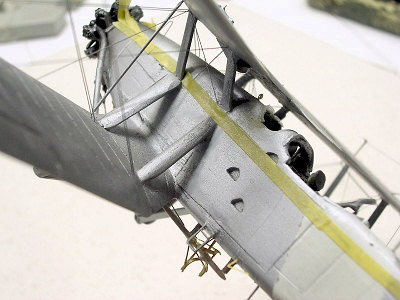 ge had 1/32 holes
drilled to take tail plane struts. Then I cut and fixed half a dozen strips of
plastic ½ x 1/8 along intervals on the inside edge of starboard fuselage half,
leaving 1/16 projecting to act as aligning keys when the two halves are joined
together with liquid cement. After joining these together these were wound with
tape to hold until set and dry. Filler was then added at the seam and sanded
when dry.
ge had 1/32 holes
drilled to take tail plane struts. Then I cut and fixed half a dozen strips of
plastic ½ x 1/8 along intervals on the inside edge of starboard fuselage half,
leaving 1/16 projecting to act as aligning keys when the two halves are joined
together with liquid cement. After joining these together these were wound with
tape to hold until set and dry. Filler was then added at the seam and sanded
when dry.
Wing halves and tail unit were then joined together, their edges were again attended to after these set hard. A small tab of plastic was inserted and glued at each wing root and forming part of the wing units. This in turn acted as a tongue to be inserted inside the slot cut in the fuselage side to take the lower wing on each side. A windscreen was cut from .010 clear piece of plastic and fixed in place. I have detailed the in line Ripon engine as far as I could make reference to the manual mentioned earlier. As for the Baffin which had a pronounced radial engine I preferred to use after market metal one. This I used Aero Club accessory E011 as the injection moulded one that came with the kit was not presentable.
Although I built the Ripon kit
long before I made the Baffin, both models were more of less same line of build
and the construction was common for both apart from the engines and that one was
built as a float plane and the other a deck landing plane. Two long exhaust
pipes characteristic to the Baffin were made from stretch sprue bent with heat
and shaped with file and knife. These were attached to a collector ring made
from a stretch sprue to have the final dimensions of3 mm diam that was bent to a
½ former 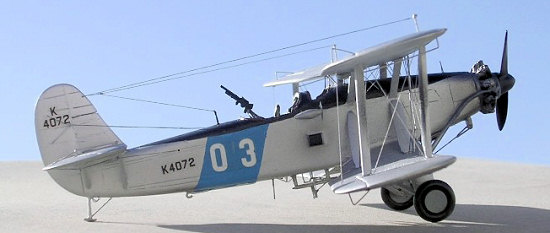 when heated and allowed to cool and set. The two bladed propeller
added to both aircraft also came from the Aero club range as the ones found in
the kit were of the incorrect shape and size. All the struts locations for the
wings, tail and undercarriage were drilled using a 0.4 dia pin drill. Suitable
jigs made from drawings given in the instruction sheet were prepared from
cardboard. These were very useful to locate and fix the upper wings in place.
While the upper wing was resting on these jigs, outer wing struts were added and
when these set with the upper wing lower surfaces, the cardboard jigs were
removed from both sides. The inner struts were now added in place.
when heated and allowed to cool and set. The two bladed propeller
added to both aircraft also came from the Aero club range as the ones found in
the kit were of the incorrect shape and size. All the struts locations for the
wings, tail and undercarriage were drilled using a 0.4 dia pin drill. Suitable
jigs made from drawings given in the instruction sheet were prepared from
cardboard. These were very useful to locate and fix the upper wings in place.
While the upper wing was resting on these jigs, outer wing struts were added and
when these set with the upper wing lower surfaces, the cardboard jigs were
removed from both sides. The inner struts were now added in place.
The assembly was allowed to set for a couple of days and following that bracing wires were added using transparent thread. Fixing the thread with super glue continued to add strength to the biplane models. The Baffin was finally had the undercarriage added making sure that it showed the correct inclined sit giving a good impression of the huge size of the carrier based torpedo and reconnaissance bomber. While the Ripon had the complex torpedo pylon and supports built from scratch using cut plastic, that for the Baffin I have used the surplus brass etch set that came with the Kora Ripon II kit built earlier in the year. (Incidentally, the review of the Kora kit in Finn AF paint scheme is among the completed kits reviews on MM). Surface detail to upper wings and rear trailing edges of both wings were made at this stage using a scriber and set of pin files. The completed model was given a final smooth sanding with wet and dry prior to applying the paintwork.
| COLORS & MARKINGS |
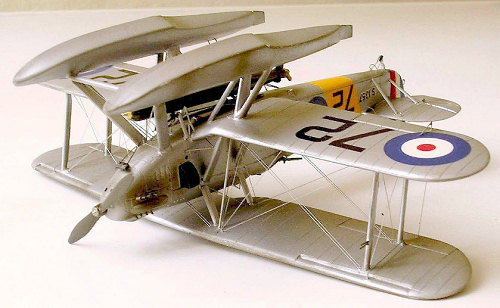 The engines and upper deck of the Baffin
was first painted black. The collector ring and pipes were basically painted
bright silver mixed with blue grey and some brown/ red mix touches. The rest of
the kit was aluminium dope overall. The Ripon was basically aluminium dope
overall with the exception of the yellow band across the fuselage. Interior of
cockpit was basically light aircraft grey with dark touches of a mix of engine
grey, matt varnish and thinner applied by air brush. Seats were leather and
straps were light tan.
The engines and upper deck of the Baffin
was first painted black. The collector ring and pipes were basically painted
bright silver mixed with blue grey and some brown/ red mix touches. The rest of
the kit was aluminium dope overall. The Ripon was basically aluminium dope
overall with the exception of the yellow band across the fuselage. Interior of
cockpit was basically light aircraft grey with dark touches of a mix of engine
grey, matt varnish and thinner applied by air brush. Seats were leather and
straps were light tan.
| CONCLUSIONS |
Building the two kits required much more time than one may think when reading the review as basically it entailed a lot of continual reference to photos of the actual aircraft in particular. Like any vac form kit build the end result was rewarding and there I have two more FAA types that used the Hal Far airfield in 1930s and just like the Gladiators the Ripon and Baffin were a very common aircraft to spot in our skies by my previous generation.
| REFERENCES |
The Blackburn Aircraft Company by Malcolm Hall
Air Publication 1423 ol1 2nd edition March 1933 issued by the Air Ministry
Heritage Encyclopedia of Maltese Culture and Civilisation No 13
Scale Aircraft Modeller Vol7 No11 August 1985
September 2007
Copyright ModelingMadness.com
If you would like your product reviewed fairly and fairly quickly please contact the editor or see other details in the Note to Contributors.